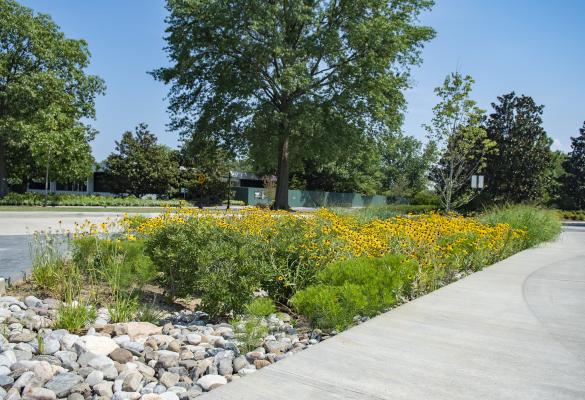Urban Stormwater and Runoff Management
Urban areas have large areas of impervious surfaces, which cause water to run off during storms (rather than retaining water or allowing it to infiltrate into the ground). This creates issues with stormwater flooding and, in cities with combined sewer systems, can also lead to sewer overflows following rainfall. Nature-based solutions (NBS) strategies for urban stormwater and runoff management such as rain gardens, stormwater parks, permeable pavement, and bioswales are intended to reduce these issues by promoting water retention, infiltration, and evapotranspiration instead of runoff (Palermo et al. 2023).

Case Studies
A Community Effort Stems Runoff to Safeguard Corals in Puerto Rico
After Record-Breaking Rains, a Major Medical Center's Hazard Mitigation Plan Improves Resilience
Arlington Stormwater Wetland Park
Camden, New Jersey Uses Green Infrastructure to Manage Stormwater
Catalyzing Investment and Building Capacity in Las Cruces
Chicago, IL Uses Green Infrastructure to Reduce Extreme Heat
County-Wide Collaboration Reduces Flood Risks and Insurance Rates
DC Utilizes Green Infrastructure to Manage Stormwater
From Gray to Green: Replacing a Bulkhead with a Living Shoreline at a High-Energy Riverine Site
Gary, Indiana Installs Green Infrastructure to Revitalize Blighted Areas, Manage Stormwater
Green Streets Active Practice Guide, Tuscon, Arizona
GreenSeams Milwaukee, Wisconsin
Harbor Brook Constructed Wetlands Pilot Treatment System
Implementing Green Infrasturcture at Multiple Scales to Enhance Resilience
Improving Pollinator Habitat on McConnell Air Force Base
Improving Water Quality by Dealing with the First Inch of Rain
Innovative Green Infrastructure Project has Diverse Funding & Financing Portfolio
Integrating Education and Stormwater Management for Healthy Rivers and Residents
Investment in Infrastructure at Sea-Level Hospital Will Pay Off by Reducing Risk
Kino Environmental Restoration Project: Stormwater Use for Habitat in an Urban Environment
Lick Run Watershed, Cincinnati, Ohio
Maywood Avenue Stormwater Volume Reduction Project, Toledo, Ohio
Navy Pier Redevelopment Project Serves as Model of Sustainability Using Green Infrastructure
Out of Harm's Way: Relocation Strategies to Reduce Flood Risk
Pittsburgh Unifies its Approach to Updating Stormwater Management
Plum and Walnut St. Green Intersection
Riverfront Park, Nashville, Tennessee
Robbins Stormwater Park and Midlothian Creek Restoration Project
Santa Fe River Restoration, New Mexico
Smart Growth Along the Riverfront Helps Manage Stormwater in Iowa City, Iowa
The City of St. Louis Park, Minnesota Increases Green Infrastructure on Residential Properties
The Restoration of an Urban Floodplain in Rahway
Trinity River Watershed, Dallas, Texas
Two Harbors: Investments in Green Infrastructure Pay Off
Using Low Impact Development Concepts to Reduce Flooding, Norfolk, Virginia
Tools
Climate Adaptation Actions for Urban Forests and Human Health
EPA Green Infrastructure Resources
FEMA Economic Benefit Values for Green Infrastructure
Financing Alternatives Comparison Tool
Green Infrastructure Effectiveness Database
Green Infrastructure Modeling Toolkit
Green Infrastructure Options to Reduce Flooding
How to Map Open Space for Community Rating System Credit
Mitigation Action Portfolio (MAP)
Mitigation Ideas: A Resource for Reducing Risk to Natural Hazards
Natural and Nature-Based Solutions Job Aid for Stormwater Management in Puerto Rico
Nature-based Solutions Website
Promoting Nature-Based Hazard Mitigation Through FEMA Mitigation Grants
Rain Gardens for Rainscapes Technical Design Manual
Risk Mapping, Assessment, & Planning
Tools, Strategies and Lessons Learned from EPA Green Infrastructure Technical Assistance Projects
Using Nature-Based Solutions Across Landscapes (Infographic)
WEBPAGE - Creating Resilient Water Utilities (CRWU)
Likely Benefits and Outcomes
This strategy is likely to achieve these project goals. Click to search for strategies with a similar benefit.
Related Green (natured-based) vs. Gray infrastructure
Explore opportunities to replace or supplement gray infrastructure with green infrastructure options.
